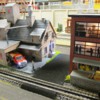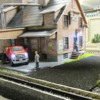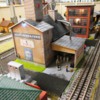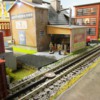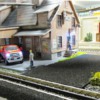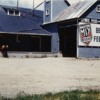i took the back off the pickup and married it to an old Lionel flatcar load.
I read on the outside of the box that Menard's power supply is required. However on the bottom of the building is a battery holder for three AA batteries. I inserted batteries in the holder but the lights did not light when I pushed the on/off button. Has anyone that removed the base found the holder not hooked up to the lights, only the receptacle for Menard's power supply?
EDIT: After reading the other thread started by Lee, It appears I got a building where the lights do not work with battery power. Should I try to take the base off as explained in the other thread or contact Menard's? It seems the hardest part is dislodging the exterior wall from the base.
I sent an email off to Menard's last night to get their ok to try and take the base off. Within Minutes I got a response of "We will get back to you". Still waiting for definitive answer. I don't wish to risk breaking the structure without some understanding of getting a replacement if I break it.
I sent an email off to Menard's last night to get their ok to try and take the base off. Within Minutes I got a response of "We will get back to you". Still waiting for definitive answer. I don't wish to risk breaking the structure without some understanding of getting a replacement if I break it.
I would think opening it up (off the base) would void any warranty implied or expressed by Meanards......at your own risk as such.....
BTW....saw a Feed & Seed on ebay at $200!! collector item already???
I sent an email off to Menard's last night to get their ok to try and take the base off. Within Minutes I got a response of "We will get back to you". Still waiting for definitive answer. I don't wish to risk breaking the structure without some understanding of getting a replacement if I break it.
Jim,
I tried to follow up this afternoon but maybe the email landed in your junk box. My first suggestion would be to toggle the on/off button a few times. On occasion, the button may stick. If that doesn’t work, we can find another solution. Just let me know.
Thank you,
Mark the Menards Train Guy
I picked up my Seed-and-Feed last week, and it worked fine. It took a little doing to make it fit in the space (or lack of) I had, but after a little rearrangement in the area, it finally fit.
The only thing I did was to add a green shade (clear plastic painted green) over the very bright LED on the side of the building. It still appears bright in the pictures below, but it is not bad at all now.
Thank you for looking!
Alex
Attachments
I believe the cyclone vacuumed the seed from the truck.
The heavy stuff falls into the elevator to be bagged.
The dust/air goes out the back. In a wood shop setup for sawdust extraction the large particles drop in barrels and the fine dust is caught in a filter.
No OSHA mandated HEPA filter on this one. Lol
I just discovered that the LED over the door on the side of my Menards Seed & Feed Building is not working. I tried giving it a little tap, but no luck. There is no opening on the bottom other than the battery compartment. I see screws on the underside of the base which appear to secure the building to the very substantial base. But, I have a feeling I am asking for trouble if I try to remove the building from the base.
Has anyone else had a problem with the LED's? If so, were you able to get it/them working?
@Jeff B. Haertlein posted:The new Feed Mill from Menards is really nice. I will have to strongly consider if I replace it with my currrent feed mill from Walthers. Note that I am calling this a feed mill. I was in the mill business for 25 years, working for my in-laws in Wisconsin. What you are calling a dust collector, isn't necessarily a dust collector at a feed mill! At our mills this is how it worked. A pick up or grain truck or our own shovelvator would bring in a load of corn (as an example) to grind and most times mix concentrates with the ground up corn. Corn would be dumped into a pit and would be dropped into a hammer mill to be ground up. The texture of the ground up corn would be mandated by a screen (like a sieve) with holes in it and depending on how fine or course the feed to be ground was to be, would determine what size screen (diameter of the holes). Attached to the hammer mill was a fan or blower. The ground corn would be sucked into the fan and blown up a pipe which was connected to a cyclone (dust collector as you people are calling them). The heavy corn would then whril around and fall back down into the cyclone, while the air and some dust would exit the upper part of the cyclone. A pipe attached to the bottom of the cyclone would then carry the corn down the pipe into the mill and into a mixer. The mixer would then mix the corn via a verticle auger inside a sleeve where it would come out the top of the sleeve and fall back into the sides of the mixer. Now while the corn is mixing, concentrates would be added to adjust the protein of the feed. Salts and minerals would be added as well, as would liquid molasses to sweeten up the feed, if desired. At our mill you then had two options. You could bag the feed out of the mixer, tie the bags, and put them on a conveyor belt to deliver them out to a farmer in his pick up truck. Or, you could auger the mixed feed out to a bulk delivery truck which had an auger to deliver it like a stoker on a locomotive delivering coal to the firebox of an engine. The other option was to let the bulk feed drop into a farmers grain truck for him to take home in bulk. So this building from Menards is really a feed mill typical of many around the country. I might also add that if you were a farmer, and picked corn out in the field, your picker, could also shell the corn (strip it off the cob), and then take it to a mill that had a dryer to dry the shelled corn. In this instance, the shell corn is dried down to a certain percentage of moisture, and then it is stored in a round steel grain bin in many cases. If the farmer chose to keep the corn on the cob, this type of picker would not shell the corn, then the farmer would elevate the ear corn into a corn crib and let mother nature dry out the cob corn; and then would be ground later. And like one reader mentioned, many farms have their own portable mixer-mills. Where the feed is ground by the power take off of a tractor. The mixer mill has screens too and a small cyclone also, and the farmer mixes his own ingredients and then pulls the mixer-mill to his feed bunkers and augers it into them. The mixer mill eliminated the need to go to a feedmill and have the feed ground and mixed. That is a good reason why so many mills are no longer in business ( like our feed mills) because of the mixer mills. And there are other reasons why the mills are closed, for instance, the family farms in our area continue to dwindle. I hope this lengthy explanation helps out with how a feed mill operates. Nice job Menards, and now I am going to go online and see how much this building costs. By the way, is Mr. Menards dog, Jack, somewhere on the model??
Seeing the latest posts, I direct you to the one I made quite awhile ago. As an update, I stayed with my Walthers feed mill as it was closer looking to our Mill where I worked. I will attach a photo of mine, and I used a Lionel Lumber Mill cyclone to simulate the collector. The Menards feed mill that I bought, went to my brother-in-law! And it looks great on his layout!
Attachments
The Walter's Feed Mill was issued as a kit, and also as a built-up, pre-assembled. Pictured is a kit, with additional paint applied. The decals are from a couple of different kits.

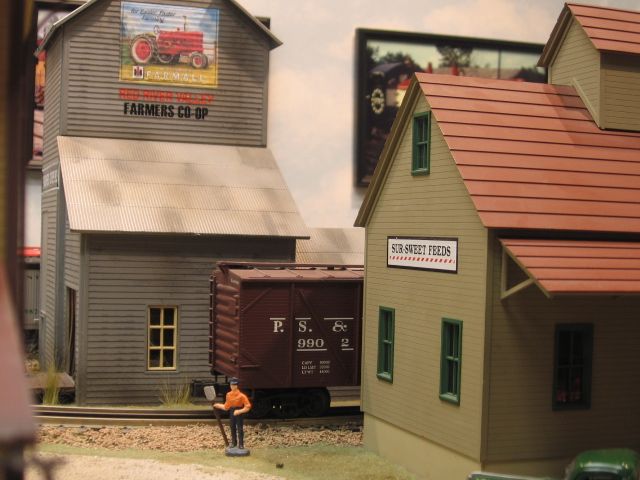
Lionel did a couple of different releases of the Grain Elevator, left in picture. ??? mid 1970's and more recent.












